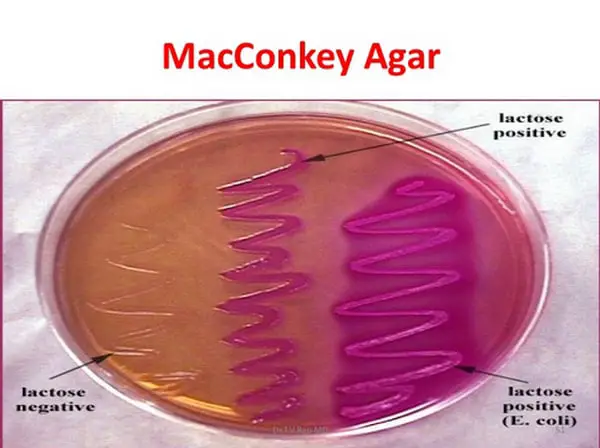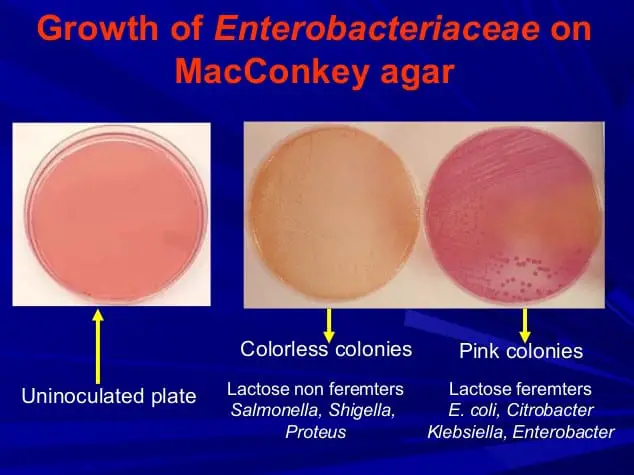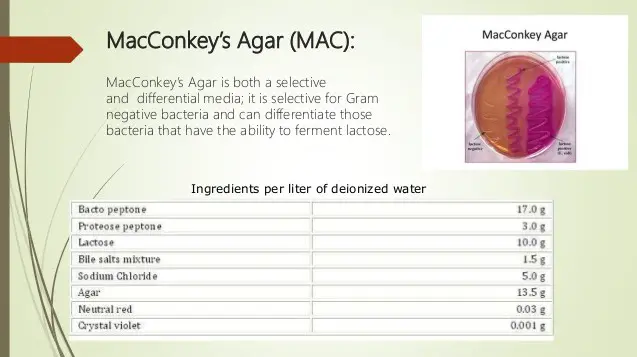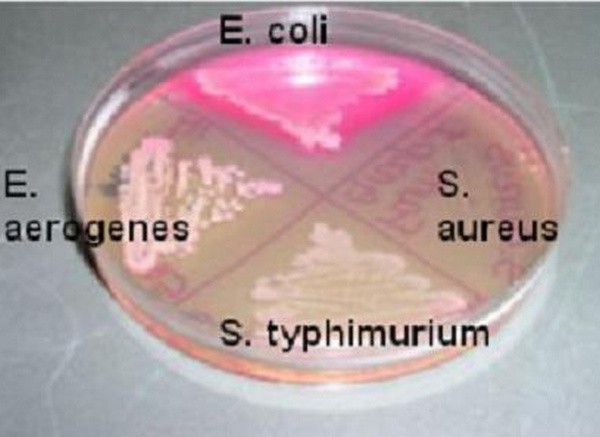What is MacConkey Agar?
What is its significance? MacConkey Agar is a differential media developed by Alfred Theodore MacConkey in the 20th century.
It is both a selective and differential media used to isolate and differentiate non-fastidious gram-negative rods such as the Pseudomonas and Enterobacteriaceae.
It uses a bacterial growth media, which is a combination of nutrients, moisture, and other chemicals necessary for the growth of bacteria. It is used to grow bacterial colonies. (1, 2, and 3)

Picture 1: A Petri dish containing both lactose positive and lactose negative bacteria.
Image source: blogspot.com

Picture 2: Images show the growth of Enterobacteriaceae on a MacConkey Agar. It has the uninoculated plate. The colorless colony shows a lactose non-fermenting bacteria while the pink colonies show lactose-fermenting bacteria.
Image source: slidesharecdn.com
Components of MacConkey Agar

Picture 3: The different components of MacConkey agar.
Image source: slidesharecdn.com
Pancreatic digest of gelatin/peptone and Protease peptone (both the meat and casein) –
They are a source of nutrients needed for growth such as vitamins, minerals, nitrogen, and amino acids.
- Agar – It acts as a solidifying agent.
- Lactose monohydrate – It provides a source of fermentable carbohydrate enabling differentiation to take place.
- Distilled water
- Bile salts and Crystal violet – They inhibit the growth of organisms that belong to the Gram-positive family.
- Neutral red – It identifies the pH level. If the pH level is below 6.8, it turns red. A colorless reading means that the pH is greater than 6.8.
- Sodium chloride – It provides essential electrolytes needed for transportation and osmotic balance. (2, 3, 4, 5, and 6)
Picture 4: A Petri dish with different types of bacteria.
Image source: superfarmer.files.wordpress.com
What is MacConkey agar Purpose ?
The purpose of MacConkey agar is to isolate Gram-negative enteric bacteria as well as to differentiate between lactose fermenting and non-fermenting lactose gram-negative bacteria.
MacConkey agar is also useful in isolating coliforms and intestinal pathogens that are present in the water, dairy products, and other forms of biological specimens. (1, 3, and 6)
MacConkey Agar Test Procedure
- The first step is to suspend 49.53 grams of a dehydrated medium in a liter of distilled water.
- Bring to boil to completely dissolve the medium.
- Autoclave 15 lbs pressure or at least 121 degrees Celsius for about 15 minutes.
- Let it cool.
- Pour into the sterile Petri plate and carefully observe what will happen. (4, 7, 8, and 9)
MacConkey agar Results
How to interpret the result of MacConkey Agar?
- Lactose fermenting strains – They grow red/pink and surrounded by acid precipitated bile. The change in color is caused by various factors such as acid production secondary to lactose, neutral red absorption, and change in the color of the dye if the pH level falls below 6.8.
- Non-fermenting lactose strains – The results are colorless and transparent. There is no significant change in the appearance of the medium. (2, 5, 9, and 10)
What bacteria are selected for when using MacConkey agar?
The strain of bacteria is identified when using MacConkey Agar. The very essence of MacConkey agar is to differentiate between lactose fermenting and non-lactose fermenting gram-negative bacteria.
Examples are as follows:
- Lactose fermenting – Enterobacter aerogenes, Escherichia coli, and Klebsiella.
- Non-lactose fermenting – Salmonella typhimurium, Proteus species, Shigella, Pseudomonas aeruginosa, and Yersinia. (1, 3, 6, and 8)
Are there any limitations?
The isolated organisms identified only give a presumptive result. The best way is to perform a subculture procedure and do confirmation test for final identification. Some strains of bacteria grow poorly in the medium while others fail to completely grow.
The incubation of MacConkey agar plate makes it susceptible to an increase in carbon dioxide which can significantly affect the growth/reduction of some strains of Gram-negative bacilli. (2, 6, and 9)
Why is MacConkey agar selective as well as a differential?
The MacConkey medium is identified as a selective and a differential medium. It is a selective medium in the sense that it inhibits the growth of gram-positive bacteria primarily because of the presence of bile salts and crystal violet in the medium.
Ironically, it is also a differential medium because it has the ability to differentiate different groups of bacteria based on the color change reaction. The pH indicator (neutral red) and the lactose produce acid in the medium which can significantly lower the pH level (below 6.8).
It turns the color to red/pink. On the other hand, non-lactose fermenting bacteria cannot use lactose in the medium. Instead, they will use peptone resulting in the formation of ammonia causing the pH to increase. As a result, gold to brown colonies is formed with dark centers. (3, 6, 9, and 10)
MacConkey Agar Facts
- MacConkey Agar is a modified neutral red bile salt agar by Alfred Theodore MacConkey.
- It is one of the earliest methods used to cultivate and identify enteric organisms.
- MacConkey Agar is useful in isolating pathogens present in foods and coliforms in water samples.
- Bacteria categorized as lactose-fermenting form pink colonies and have a zone of bile salt precipitate surrounding it.
- Non-lactose fermenting bacteria develop into colorless and transparent colonies. There is no precipitation formed.
References
- https://en.wikipedia.org/wiki/MacConkey_agar
- https://microbiologyinfo.com/macconkey-agar-composition-principle-uses-preparation-and-colony-morphology/
- http://www.austincc.edu/microbugz/macconkey_agar.php
- https://microbeonline.com/macconkey-agar-mac-composition-preparation-uses-and-colony-characteristics/
- http://iws2.collin.edu/dcain/CCCCD%20Micro/macconkeyagar.html
- https://catalog.hardydiagnostics.com/cp_prod/Content/hugo/MacConkeyAgar.html
- https://www.teknova.com/category-s/504.html
- https://www.quora.com/How-do-you-prepare-MacConkey-agar
- https://www.sigmaaldrich.com/catalog/product/sigma/m7408?lang=en®ion=PH
- http://www.scienceprofonline.com/microbiology/macconkeys-agar-mac-differential-selective-bacterial-growth-medium.html

